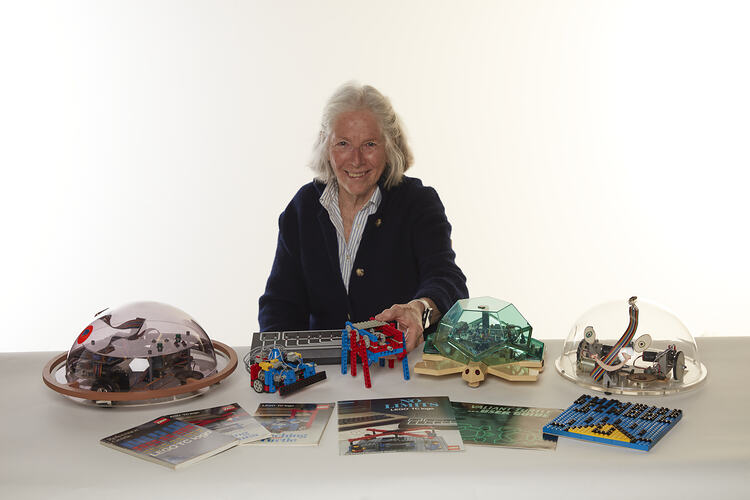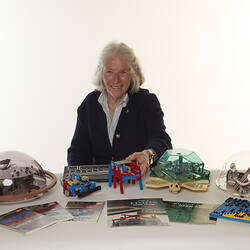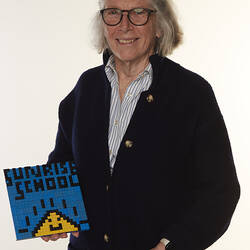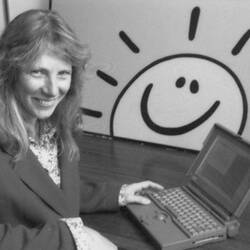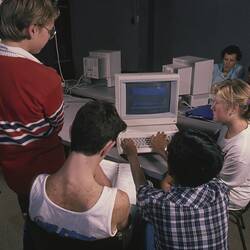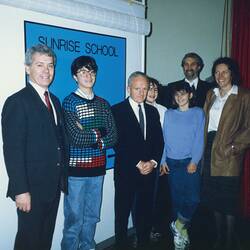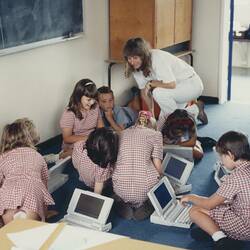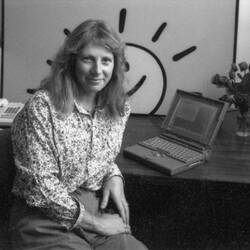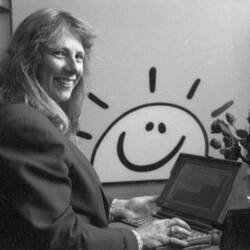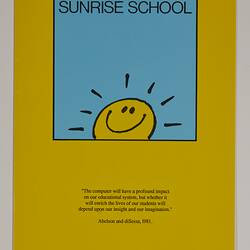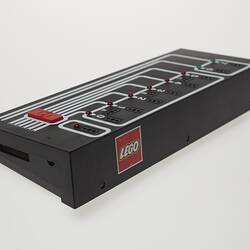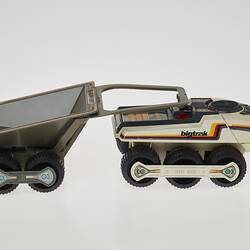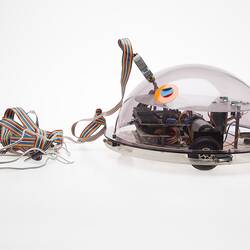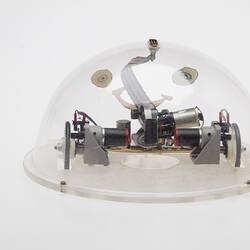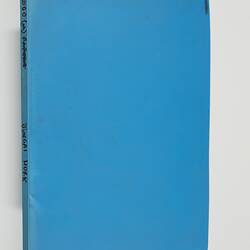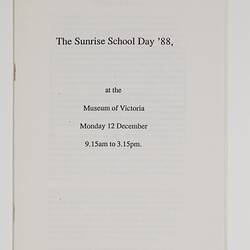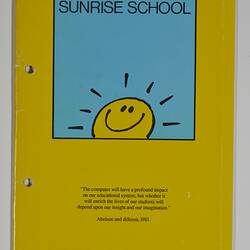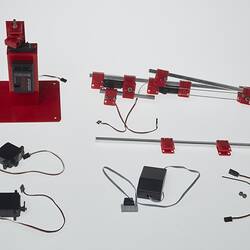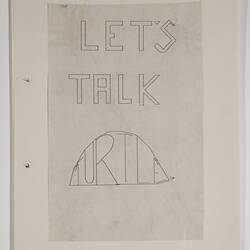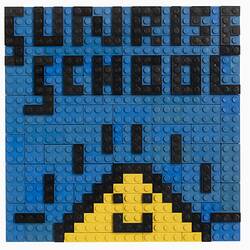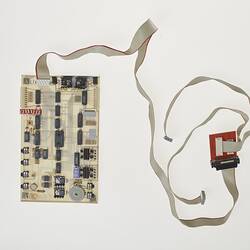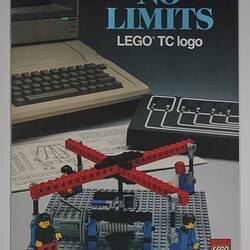Elizabeth 'Liddy' Nevile (born 1947) is an Australian academic and pioneer in Australian educational computing.
Liddy (then Elizabeth Game) was born in Melbourne and attended Melbourne Girls Grammar School. After leaving school at 16, Liddy began studying at Monash University and spent a year at Perugia University in Italy. In 1968 she returned to Australia and married Peter Nevile, and in 1973 she graduated from Monash University with degrees in pure mathematics and law.
Through the 1970s and early 1980s she taught law at the David Syme Business School (Monash University), using computer technologies to introduce new teaching and learning approaches. During this period, she and her husband had four children.
In 1980, Liddy was exposed to school educational computing when her primary school-aged son, Charles Neville, was invited to be part of a project being conducted by Pauline Adams, a Monash University Masters student. This project involved the use of Logo, the world's first computer programming language designed for children and learning. Some of the programming projects designed by Charles and other children working with Adams would inform those published in the 'Learning LOGO' educational book series co-authored by Adams.
Liddy's interest in educational computing was piqued, and she quickly became involved in extending the use of computers and Logo at her son's primary school (Glamorgan). Liddy was appointed an Educational Technology Consultant at Glamorgan, immersing herself in classroom computing at the school where every child ranging in age from three to twelve years would come to use computers twice per week. Based on this classroom experience, Liddy and freelance editor, Caroline Dowling, wrote a series of Learning with Logo student workbooks and accompanying teacher and parent manuals under the titles "Let's Talk Turtle" and "How Turtles Talk". These were published between 1983 and 1988.
Liddy's interest in educational computing extended beyond Glamorgan, and she became part of an enthusiastic network of teachers and researchers leading developments in Australian educational computing. She joined the Computer Education Group of Victoria (CEGV) and began contributing to the group's journal COM-3 in 1982. In 1983, she helped CEGV create the Computer Access Scheme, an innovative community computing access and teacher training program based at the South Yarra Library. This scheme was the basis for founding CEGV Services, an arm of the organisation that was at the forefront of providing teacher professional development, school computing and community access services through the 1980s. Liddy coordinated CEGV Services from 1983 to 1984 and served as CEGV President from 1987 to 1988.
Liddy also actively sought to engage with international scholars and practitioners at the forefront of the educational computing movement. In 1981, together with Carolyn Dowling, she made an extensive international tour of educational research bodies. She established relationships with a number of key figures, including Seymour Papert at Massachusetts Institute of Technology (MIT) whose constructionist learning theory and Logo programming software were influential. Over the course of her career, Liddy helped to bring many of the world's leading educational computing experts to Australia, making a major contribution to local knowledge, policy, and practice.
In 1984, Liddy joined Australian computer hardware and software distributor Barson Computers. Barson were the Australian supplier for the BBC Microcomputer which had become the mainstay of educational computing in Britain. By the mid-1980s, the BBC Microcomputer would also be the only computer approved by every Australian State and Territory Education Department, and Barson secured a number of school supply contracts. To support the company's role in educational computing Liddy was employed as its first Director of Research. Between 1984 and 1986, Liddy explored and introduced a range of digital technologies (such as laser disks) and new approaches to computing into Australian schools.
In 1987, Australian Council for Educational Research (ACER) appointed Liddy as Director of its new Education and Technology research theme. This was one of five triennial themes ACER would research over the period 1987 to 1990. After taking up the role Liddy worked with ACER Director, Barry McGaw, to reshape the investigative brief away from a techno-centric evaluation of how computers were being used in classrooms to an exploration of the type of educational environments and cultures in which the power of computers might best be harnessed to enhance learning. They hoped this would provide a glimpse into what schooling might look like in the future. This approach reflected her previous work with educational technologies. It also drew upon the theoretical and applied work being conducted by a core group of scholars and practitioners associated with the Constructionist learning theory and Logo computer software, many of which were connected to the MIT Media Lab.
At ACER, Liddy initiated work under the Education and Technology theme by collaborating with the Museum of Victoria to create the Sunrise School. The school was originally referred to as the School of the Future, in reference to a similar project that had recently been completed by Papert and his colleagues from the MIT Media Lab at the Hennigan School in Boston. In fact, Liddy recruited Papert along with others from MIT to be part of the Sunrise School's International Advisory Panel, bolstering the array of intellectual resources available to the project. Similarly, Liddy drew on her existing connections with technology suppliers, including Barson Computers, to assist with the provision of computers and equipment for the Sunrise School.
In 1988, the Sunrise School opened at the museum as a technological and culturally rich learning environment accessible to select groups of students and teachers, pre-service teachers and educational researchers. The core group of users was two classes of Year 8 students and their teachers from Princes Hill Secondary College. They spent two afternoons each week onsite through the 1988 and 1989 school years engaged in exploratory learning activities. The activities aimed to emphasise student engagement in constructing personal knowledge through largely self-directed processes of creating digital and material items that made use of the school's computer and robotics technology within the context of the museum environment.
The Sunrise School's innovative approach quickly garnered public attention, as well as the interest of those in the education sector. Having attended the school's official launch by Victorian Education Minister John Button in June 1988, the Principal of Methodist Ladies College (MLC), David Loader, sought to engage Liddy to assist in rethinking the use of computers at MLC. Liddy's consultation led to the establishment of a Sunrise Centre at MLC in 1989. In its first year, the MLC Sunrise Centre ran a pilot program with one Year 7 'Sunrise Class'. The class used desktop computers and robotics technologies and undertook the type of independent constructionist learning activity that was emerging as central to what might be called 'Sunrise' practice.
In 1990, MLC expanded the number of Sunrise Classes to six and also introduced one-to-one personal computing with all Grade 5 students having access to their own laptop computer at school and home. These laptop classes and MLC's commitment to becoming a laptop school were a world first! The impact of this Sunrise-led transformation was significant and wide-reaching. Teachers and administrators from across the world flocked to the school seeking insights into how they might transform their own schools and practices! Liddy expanded ACER's Sunrise program further through her work with the Queensland Department of Education to establish a Queensland Sunrise Centre. The centre, based at Combabah State Primary School on the Gold Coast, began operation in 1990. At the school, sixty Year 6 students and their teachers entered the Sunrise program using a mix of desktop and laptop computers and other digital technologies as they explored the new approaches to learning and teaching associated with Sunrise practice.
In June 1990, Liddy coordinated a Sunrise LEGO-Logo workshop as part of the World Conference of Computers in Education held in Sydney. Key participants in the two-day workshop included two of the developers of the LEGO-Logo robotics system, Steve Ocko and Mitch Resnick from MIT. A number of students and teachers from each of the three Sunrise locations (the Sunrise School at the Museum, the MLC Sunrise Centre and Queensland Sunrise Centre) also played a key role as instructors.
In 1991, at the conclusion of the Education and Research Theme's 3-year term, Liddy left ACER to take up an academic position with RMIT University. ACER continued its educational technology research under a new triennial theme 'Cognition, Technology and the Classroom', producing some important findings from the ongoing work being conducted at the Queensland Sunrise Centre.
Liddy formed the Sunrise Research Laboratory at RMIT in 1991. She continued her work in educational computing there through the 1990s, bringing together teachers, students, researchers and industry partners in a wide range of research and development projects. One of the early projects involved the formation of what would effectively be the last of the Sunrise Centres, this one based at the Batlow Central School in the small New South Wales town of Batlow. In 1992, a class of Year 3 students were given access to laptop computers and Logo software, and their teacher provided support in designing classroom activities aligning with the 'Sunrise' practice.
Liddy's work at the RMIT Sunrise Research Laboratory increasingly engaged with the World Wide Web. One such project resulted in the production of the OZeKIDS CD-ROM series that provided tutorials on web browsing and web development. Twenty-five thousand OZeKIDS discs were sold to schools and for private use. Another focus of her work with the Sunrise Research Laboratory was to improve use of digital technology by RMIT staff. This resulted in the introduction of the Sunrise Professional Development program. Liddy undertook research on this program as part of a Master of Education at RMIT which she completed in 1994.
Through the 1990s and 2000s, Liddy became increasingly involved in the development of World Wide Web standards. She was instrumental in assembling a successful case for opening an Australian branch of the World Wide Web Consortium (W3C) - the primary international standards organisation. Her research and advocacy work on standards has focussed on inclusion and accessibility. In 2009, she completed a PhD at RMIT University with a thesis titled: "Metadata for user-centred, inclusive access to digital resources: realising the theory of AccessForAll Accessibility".
Although 'officially retired' Liddy remains an active contributor to a number of World Wide Web standards organisations.
The Sunrise Collection at Melbourne Museum contains a range of items related to Liddy's work centering on the Sunrise School and Sunrise Centre programs.
References
Braggert, E.J. (1993) Laptop Use at Batlow Technology School. Charles Sturt University.
Brand, S. (1987) The Media Lab. Viking Penguin. Com3 Journal. Various issues, including: n33, n34, n36, Vol. 10, n1, Vol. 13, n4, Vol. 15, n2, Vol. 12 n1. (Collection held by the State Library of Victoria).
Finger, G. D. (1995) Evaluating the integration of learning technology in Queensland state schools: A case study of the Queensland Sunrise Centre. Australian Council for Educational Research.
Johnstone, B. (2003) Never Mind the Laptops: Kids, Computers, and the Transformation of Learning, iUniverse
Loader, D. (1993) 'Reconstructing an Australian School', in Grasso, I., & Fallshaw, M. (Eds.). Reflections of a learning community: Views on the Introduction of Laptops at MLC. Melbourne: MLC.
Loader, D. (1993) 'The Audacity of Sunrise', in Grasso, I., & Fallshaw, M. (Eds.). Reflections of a learning community: Views on the Introduction of Laptops at MLC. Melbourne: MLC.
Nevile, L. (1990) Sunrise. Unpublished Report. ACER.
Nevile, L. & Dowling, C. (1983) Let's talk Apple Turtle (teacher's and parent's edition). Prentice-Hall.
Nevile, L. & Dowling, C. (1988) How BBC Turtles Talk. Cambridge University Press.
Rowe, H. A., Brown, I., & Lesman, I. (1992) Learning with personal computers: issues, observations and perspectives. Australian Council for Educational Research.
Ryan, M., Betts, J., Grimmett, G., Hallett, K., & Mitchell, D. (1991) The Queensland Sunrise Centre: a report of the first year. Australian Council for Educational Research.
More Information
-
Keywords
-
Authors
-
Article types
